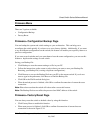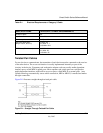
Port-Based VLAN C-1
July 2005
Appendix C
Port-Based VLAN
Port-based VLAN will help efficiently confine the broadcast traffic to the switch ports. This switch
allows up to 26 port-based VLAN groups, any one port can belong to different VLAN groups. The
default VLAN group port-based VLAN that have all ports belonging to VLAN 1.
Port-based VLANs
Packets received by the switch will be treated in the following way:
• When a packet enters a port, it only can proceed to the VLAN which the port belongs to. The
packet will be able to be sent to other ports with the same VLAN ID membership.
• If the port in which the packet entered does not have membership with the same VLAN as the
source port does, the packet will be dropped.
Example
This example basically demonstrates how the port-based VLANs work to meet your needs.
Setup the following VLANs, each with defined descriptions:
• VLAN 1 (IT department)
• VLAN 2 (Sales department)
• VLAN 3 (Marketing department)
• VLAN 4 (Accounting department).
Configure the VLAN membership. Be sure to set all of them as follows.
• Setting up second VLAN group (Sales), VLAN ID = 02, with membership of ports 1~8, 25.
• Setting up third VLAN group (Marketing), VLAN ID = 03, with membership of ports 7~14,
25.
• Setting up fourth VLAN group (Accounting), VLAN ID = 04, with membership of ports
19~20, 25.


















